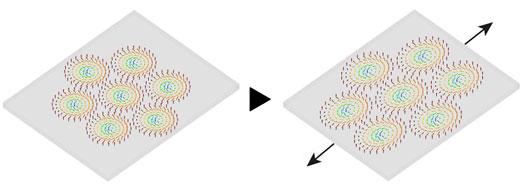| Posted: Oct 09, 2015 |
Stretching a material offers a way of tuning an exotic form of magnetism
(Nanowerk News) A method for controlling magnetic skyrmions through applying a strain to a material has been demonstrated by RIKEN researchers ("Large anisotropic deformation of skyrmions in strained crystal"). Such skyrmions are potentially useful for low-power magnetic memories.
|
|
Magnetism occurs in a solid because of an intrinsic property of electrons called spin. This can be visualized as an arrow pointing along the axis about which the electrons rotate. In most materials, the arrows point in random directions, but they are ordered in magnetic materials due to ‘spin–spin interactions’. To harness spin for device applications, a technique is needed for controlling this ordering through the application of an external field.
|
 |
| Figure 1: Applying a small strain in one direction (indicated by black arrows in the right sample) dramatically alters the shape of a skyrmion crystal and the individual skyrmions making it up. (Image: Kiyou Shibata, University of Tokyo)
|
|
Kiyou Shibata of the University of Tokyo and co-workers at the RIKEN Center for Emergent Matter Science have now demonstrated a mechanical method for controlling the shape of an exotic form of magnetic ordering known as a skyrmion. The distribution of spins in a skyrmion resembles a vortex: the spin points down in the center, the spin in concentric circles about the center is rotated at increasingly large angles with distance from the center, while the spin on the outside points upwards. Skyrmions have been observed both individually and in groups having crystal-like structures, known as skyrmion crystals.
|
|
Previously developed methods for controlling skyrmions include applying electric currents and altering the chemical composition of a material. Now, Shibata and his team show that a skyrmion crystal can be tuned by stretching the host material. “This effect can be exploited by using voltage-induced strain in piezoelectric hybrid devices,” says Shibata.
|
|
The researchers attached both ends of a trimmed iron germanium thin plate to a silicon frame and then thinned the center region of the plate to 150 nanometers. When the temperature was reduced, the iron germanium and silicon contracted at different rates, creating strain in one direction of the sample.
|
|
The team created a skyrmion crystal by cooling the sample while applying a magnetic field and imaged it using a technique called Lorentz transmission electron microscopy. In this way, they observed large elongations of both the skyrmion crystal and the individual skyrmions making it up as the sample was cooled from 260 to 94 kelvin (Fig. 1).
|
|
Magnetic skyrmions arise because of a certain spin–spin interaction. These results reveal that a strain as small as 0.3 per cent can greatly affect this interaction and distort the skyrmion crystal lattice by more than 15 per cent.
|
|
“We think that these properties could provide a practical way for manipulating skyrmions and may pave the way for developing devices that use them,” says Shibata.
|

